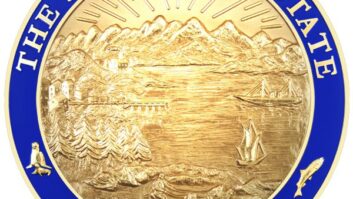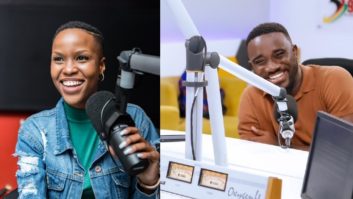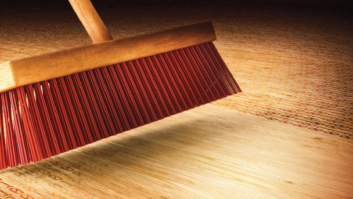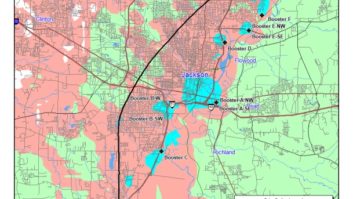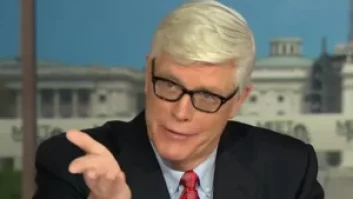AUSTIN, Texas It was one of the stranger NAB Radio Shows. Hurricane Ike forced the evacuation of thousands of people along the Gulf Coast in September. More than 1,000 displaced Houston-Galveston area residents were sheltered in part of the Austin Convention Center while the broadcast show was held a few hundred yards away.
Exhibit hall hours were limited to 12 hours total. Talks about the worsening economy, whether the bleak outlook will extend into the first part of 2009 and radio’s struggle to grow were overarching themes to hallway discussions.
Final attendance was announced at 2,743, down from last year’s approximately 3,100. An NAB spokesman said “drive-in” traffic that normally materializes “was pretty much non-existent this year because of Hurricane Ike, and because some 60 radio stations in Texas were off the air during our show trying to get their facilities back on the air.”
Here’s a summary of some of the happenings at the show. Digital radio news is handled in a separate article, see page 18.
Rehr: ‘Negativity’ Threatens Biz
Negativity about radio, particularly from those in the industry, is “pervading the radio business and threatens to paralyze us,” NAB President and CEO David Rehr told several hundred NAB Radio Show attendees as he delivered his annual state of the industry address.
He opened the three-day show by acknowledging, “It’s not surprising that some of you may be feeling this pessimism. It’s a dark cloud hanging over our heads. And we feel bombarded by negative — and often false — messages that reinforce these feelings.”
We hear that radio is obsolete and not adapting fast enough to the digital age, he added; but what we don’t hear are the success stories. “Radio connects, informs and inspires an estimated 235 million listeners each week,” said the NAB chief executive.
“Right now, radio needs people who believe,” Rehr said. “We need people who are bold and who will take charge of leading us into the future.”
Rehr listed radio’s technological highlights. In addition to HD Radio and new delivery services, he said broadcasters are “undertaking an effort to increase the number of FM radio receivers in cell-phone handsets.” He did not mention AM radio.
NAB is working with the HD Digital Radio Alliance to further the rollout of HD Radio, targeting automakers and dealers with the message that your car is not “fully equipped” unless it includes HD Radio, he said. They’ve taken the message to auto shows in Detroit, New York and Los Angeles and used billboards to get the attention of automakers commuting in Detroit “and they’re listening.”
A new generation is coming to radio through the iPhone; in fact, “AOL Radio powered by CBS is one of the most downloaded applications for the iPhone,” Rehr said, also mentioning that owners of the new Microsoft Zune player will have the ability to tag and purchase songs directly from the radio.
Rehr called the Federal Communications Commission inquiry about whether broadcasters ought to be regulated by certain localism rules “misguided” and praised broadcasters in general, and Texas broadcasters in particular, for their commitment to covering Hurricane Ike.
The FCC’s proposal to bring back 24/7 staffing regulations and mandating having a main studio in the city of license “ignore the realities of the broadcasting business and technology,” said Rehr.
The text of his speech can be found on pages 45–46.
Pogue: ‘Where Does Radio Fit In?’
“Where does radio fit in?” asked New York Times technology critic David Pogue, who discussed topics such as VoIP phones, WiFi, on-demand media and new Web developments. He linked the technologies and said all reinforce each other, often in initially unseen and unexpected ways.
The next generation of consumers expects things on-demand, he said, noting that technology is advancing rapidly. “Universal wireless would help this industry a lot,” he said as he named numerous wireless Internet gadgets, some of which can be implanted with a radio chip.
His lively and funny performance included demos of fresh technologies such as “Goog411,” a free information service that lets consumers avoid paying $2 for a directory assistance-placed call.
He also parodied the RIAA for suing teenagers and grandmothers for downloading pirated music, singing to the Village People’s “YMCA.”
Large Advertisers = Skewed Perceptions
Several group heads argued that there’s nothing wrong with radio but that it has a perception problem among large advertisers. Entercom CEO David Field said the key is to reach decision makers before media planners cut radio advertising out of a planned buy.
All of the group heads on hand said their companies are embracing new technology to put content on new platforms, but a lot of the discussion was about developing content to draw people to those new offerings.
Emmis CEO Jeff Smulyan noted that he and some other major group heads are meeting with top executives of major wireless telecom companies to persuade them to put radio receiver chips into cell phones, a recent stated goal of NAB leaders. His goal is to have a radio chip in every new cell phone in a few years; he said, “We’re on our way.”
Group Heads Fume About Future Sat Tuners
Group heads speaking at a Dickstein Shapiro financing panel criticized the FCC for not mandating HD Radios in new satellite tuners as part of the conditions Sirius and XM had to accept for the agency to approve the merger.
Clear Channel CEO Mark Mays said, “I don’t know how they allowed XM and Sirius to merge into a monopoly.” The commission didn’t have “the backbone” to do the right thing, he said.
CBS Radio CEO Dan Mason said, “Unless we’re in the box at the factory level, AM could become extinct.”
Martin Urges Industry Plan to Soothe Localism Concerns
Speaking of the future of AM, FCC Chairman Kevin Martin told NAB Radio Board Chair Russ Withers and attendees during the annual “Chairman’s Breakfast” that radio’s migration to digital will “level the playing field” for AM stations that are suffering from poor audio quality.
Martin acknowledged the importance of the agency facilitating the industry’s digital conversion but also said that he thinks tuners should be able to receive an array of signals including analog AM/FM, HD Radio and satellite radio signals.
He noted that the commission released a public inquiry seeking public comments on whether HD Radio should be mandated in satellite tuners, or vice versa. Martin couldn’t say how his fellow commissioners come down on the issue.
The Republican appointee is expected to tender his resignation in January as a new administration comes in; so Martin likely will be gone long before any decision is made on the issue.
Switching to localism and the possibility of mandated 24/7 staffing, Martin said Congress is concerned that broadcasters aren’t taking their public service commitment seriously and said there’s a lot of “angst on Capitol Hill over it.”
The chairman encouraged broadcasters to come up with a plan offering solutions to address lawmakers’ concern about the overnight staffing of stations and about voice tracking. He noted that while lawmakers on the Hill understand the role individual stations play in performing public service to their communities, “there is concern about broadcasters as a whole.” Martin urged resolution by year-end.
(click thumbnail)FCC Commissioner Jonathan Adelstein, foreground, with NAB Radio Board First Vice-Chair Steve Newberry of Commonwealth Broadcasting. © NABAdelstein: Radio’s Future Is Local; Opportunity Missed for HD-R
FCC Commissioner Jonathan Adelstein, meanwhile, isn’t so sure localism will be wrapped up by the end of the year. In a separate event, though, he said, “The NAB has raised a ruckus,” telling attendees, “You have a very effective advocacy campaign.”
The goal of the initiative, he said, isn’t to tie broadcasters’ hands but to address ongoing concerns, saying “We don’t want another Minot,” a reference to a 2003 train derailment when tank cars carrying anhydrous ammonia burst in that North Dakota town.
Clear Channel owned most of the radio stations in that market then. City officials said they couldn’t contact station personnel quickly in order to warn residents of the resulting poisonous gas cloud; Clear Channel said officials didn’t have their EAS equipment installed and didn’t know how to use it to send an alert, though an alert eventually aired.
Those who argue in favor of returning the 24/7 staffing and main studio rules fear consolidation has left many stations empty at night and another incident similar to the Minot situation could occur. Broadcasters say the expenses of bringing the rules back could make many stations fail.
To wrap up that issue, Adelstein said that broadcasters have a “good future” if they “stick to local communities” and provide local content to their audiences.
The Democratic commissioner had strong words about another issue: whether HD Radio reception capability should be mandated in satellite receivers. Before the agency approved the merger, Adelstein tried to win this concession. Failing that, he said, he changed his vote to oppose the merger.
“That didn’t go very well,” he said of the commission’s 3–2 vote in favor of the merger, with Adelstein and fellow Democrat Michael Copps in the minority.
He wanted a prohibition on the merged sat rad company subsidizing automakers for including receivers in cars that “discriminate against HD Radio.” The satcasters did agree not to develop a combined radio that couldn’t include the IBOC technology, but that’s not the same as mandated inclusion.
Adelstein questions whether the FCC has the authority to force manufacturers to include IBOC chips in sat tuners now that negotiations with the satcasters are over.
“With Sirius/XM we had the authority because it was voluntary.” He noted that the FCC is investigating the issues through a Notice of Inquiry on the topic; however he added, “I will be surprised if we can come up with a good legal basis to require HD on receivers.”
The key to advancing HD Radio is to get the technology into cars, he said.
Adelstein also said he wants to see radio receivers in cell phones. “We need to work on making that a reality.”
Shortly after the show, Rep. Edward Markey, D-Mass., introduced the ”Radio All Digital Channel Receiver Act,” a bill to mandate that all satellite radios be able to receive HD Radio signals.
Haley Talks Up Online Revenue Potential
Radio Advertising Bureau President/CEO Jeff Haley said radio’s challenge is offering shifting choices to advertisers as more of radio’s programming is offered online. New technology doesn’t necessarily mean fewer people will listen to radio, he said, noting that radio is the number six choice among iPhone applications.
The FM adapter is also popular on iPods, he said. Continuing this theme, “We want FM receptivity on every cell phone” and all digital devices within five years, Haley said during the Radio Luncheon.
Pointing to RDS, he said that’s a system in which the point of contact to the user can be for sale, serving as a revenue generator for radio’s partners.
Haley premiered a video about radio that the RAB hopes stations will post online and use it to remind listeners about radio’s potential.






